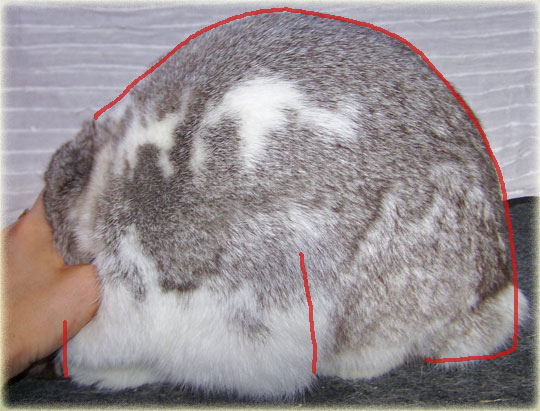Posing Mini Lops & Evaluating Body Type
Posing Mini Lops can be challenging for some people, particularly those who are new. It can be hard to know exactly what to look for, when you've only read a book on what their standard is and haven't actually felt or visibly seen it all.
When I first started Mini Lops, I had a breeder come to my barn and she went through my whole herd showing me their bad points & their good points. That helped me SO much and gave me a much better eye for what to look for. It also helped make their standard a lot easier to understand. For any breeders who are local to us here in Oklahoma, I'd be happy to come to your barn and evaluate your herd for you. Or, you are welcome to come to our barn and I can show you the ABC's of posing & evaluating Mini Lops.
Mini Lops are to be posed flat on the table. The tip of their front toes should be even with their eyes and the tip of their back toes should be even with the front of their hip.
You can view Evaluating Body Type in Baby Mini Lops here.
So, with all that said, let's get onto going over Mini Lop type.
General Body Type (ARBA Standard of Perfection):
"Body--The general aspect is of a massive, thickset body. Shoulders are to be broad, with good depth, well filled and rising to a slightly heavier hindquarter that is broad, deep, smooth, rounded and with the lower hips being well filled....The Mini Lop is to be heavily muscled, compact and balanced. A dewlap is permitted on does and should balance with the rest of the rabbit. Faults--Long, narrow body; flatness over shoulders or hips, chopped off or undercut hindquarters; any specimen that shows raciness; large dewlap on does.
Head--The head is to be strongly developed and sturdy, without being too narrow. It is to be wider in bucks and finer in does. The head is to be ser cloesly on the shoulders, with the neck as short as possible. The crown of the head is to be boldy arched. There should be a slight curvature of the skull from the base of the crown toward the nose. The head should be bold and balance with the rest of the body. Faults--Long, narrow head; pointed nose.
Ears--Ears are to be well placed on top of the head, rising from a strong basal ridge and lopping vertically on both sides of the head. The ears should hang close to the cheeks, with the ear openings turned toward the head. The outline of the ears and crown should resemble a horseshoe shape. The length and width of the ear are to be in proportion, and balance with the size of the head and body. The ears should be well furred and well rounded at their extremities. Faults--Poor ear carriage; narrow ears; very thick or very thin ears; folds in ear; ear openings turned away from the head."
Note on Posing Mini Lops from the ARBA Standard of Perfection:
"Note: It is the utmost of importance that a Mini Lop be properly posed. When properly posed, the toes of the front feet will be resting just under the cheeks and even with the eyes. the toes on the rear feet wil be even witht he haunch or thigh joints. If the rear feet are pushed up under the belly or rib section, the rabbit is not posed properly and cannot be accurately evaluated."
This first set of pictures are what you want in a Mini Lop. How to pose them correctly and what you should see in a well posed mini lop with good type.
If you want to be able to print out a diagram of what to look for in a Mini Lop, click here to automatically move down to the bottom of the page, and we have a custom built Mini Lop diagram that can be easily printed and used as an education resource.
Back to Posing Mini Lops
|
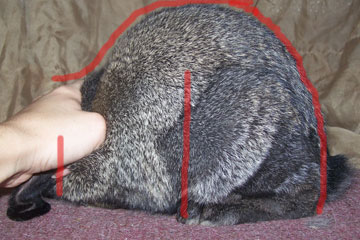 |
This doe is a good example of a well balanced, deep doe. A very good example of the overall body type that a Mini Lop should have. She is a larger doe overall, so some will be shorter in body than she is. But, she is balanced out very well and has nice depth
Note: See where the two lines are from the bottom? Those are at the tip of her toes to show where the feet should be placed when posing. |
This is a young jr. buck, but he shows the overall type that a Mini Lop should have very well. His rise starts right at the base of his neck, goes up to a very nice, deep rise over the middle and curves back down to a very full hindquarters.
Note: The lines that start at the tip of his toes are to show where the feet should be placed for proper Mini Lop pose. |
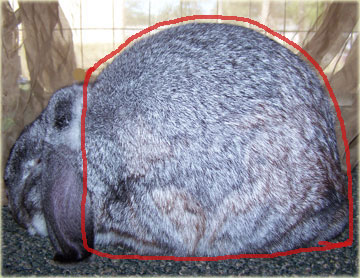 |
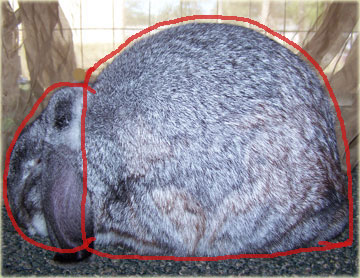 |
| This picture shows a great example of the well balanced, well rounded, short, smooth & deep body that a Mini Lop should have. | This is the same rabbit and the same picture. I just put this picture here to show the roundness of the head on a well balanced animal. |
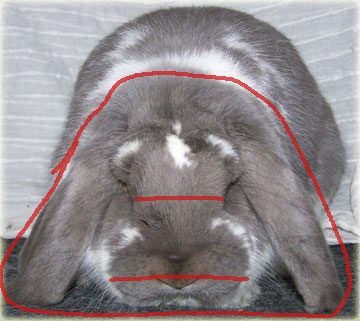 |
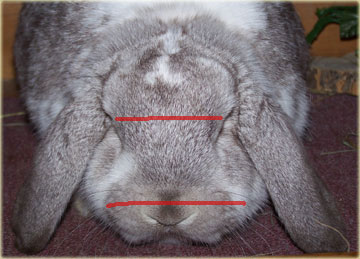 |
| This picture shows an ideal Mini Lop head. Notice how full, wide & thick the crown is. How loose & easily hanging the ears are. And how wide & thick the face is. He has very nice width between his eyes and a wide, full muzzle. | Many times a doe's head will be smaller than a buck, but this is an example of a doe with a very nice, wide head. Notice how much width she has between the eyes and how full her muzzle is. |
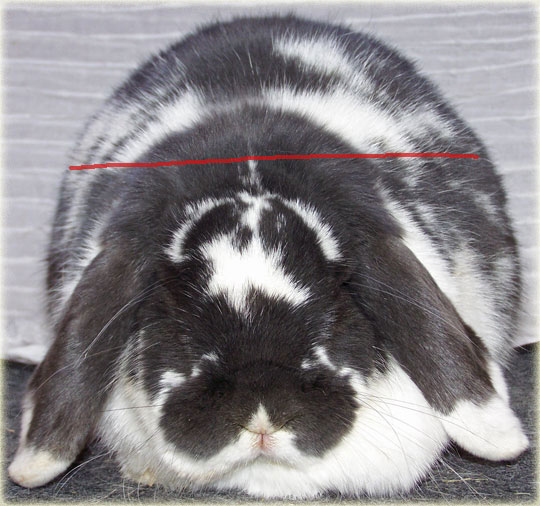 |
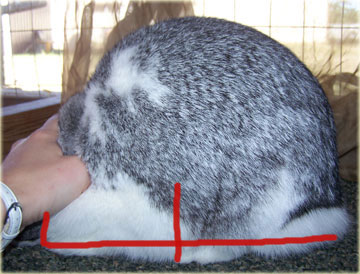 |
| This is a very good example of the width a mini lop should have when properly posed and viewed from the front. | This picture shows how short a mini lop should be. They should be very short in body when posed correctly. |
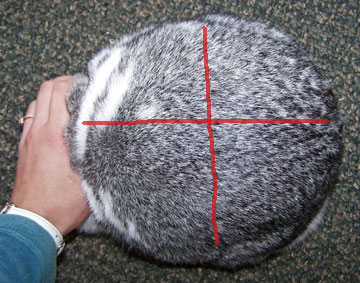 |
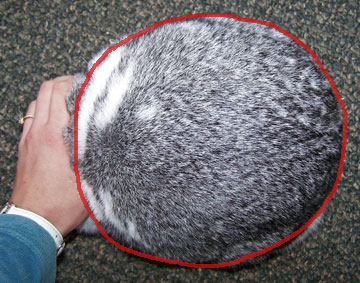 |
| Ideal mini lop type, when viewed from the top should be almost equal in both their length and width, like the above picture shows. Some will be slightly longer in length than their width, but so long as they are a well balanced animal, they are fine. | You can see in this picture if the rabbit is as long as they are wide, that when viewed from the top, the body should be quite round. |
This second set of pictures, below, shows mini lops that are not posed properly and therefore make the rabbit look like it has bad type. |
|
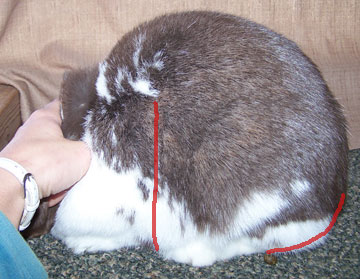 |
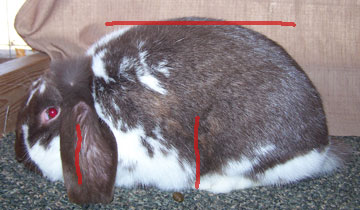 |
| This is a rabbit which is over posed. It's front feet are pushed way too far forward. Which therefore makes it look like it has undercut hindquararters and peaks too soon. | This rabbit is under posed. It's back feet are not under it enough and it's front feet are also not in position. Which therefore makes it look long in body and flat over the top. |
This third set of pictures, below, shows some of the more common faults typically seen in mini lops. And also some rabbits that just aren't quite ideal. |
|
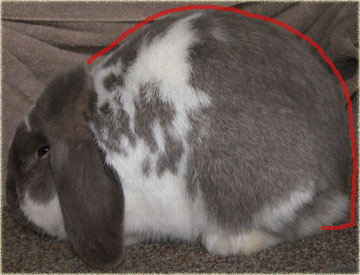 |
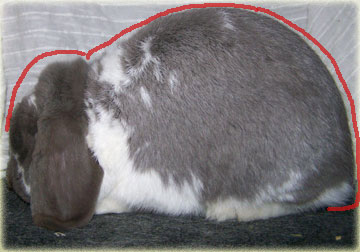 |
| This buck is a very nice rabbit and balances out well, but he is not as deep and short in body as is ideal. | This is also very well balanced, but he lacks a lot of depth and shortness of body. |
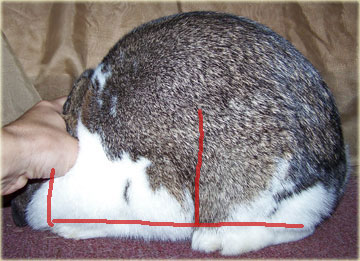 |
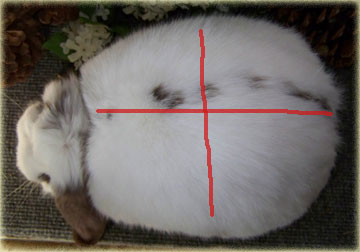 |
| This doe is a very nice animal and is well balanced, but she is longer in body than what is preferred. If you compare her length of body with the rabbit pictured above (4th picture down on the right in the first set), you will see the difference. | This is a top view of a rabbit that has extra length in her body and is not as short as she should be. You can really see the difference if you compare this picture with the picture above (last set of pictures in the first set). She has more length to her body than she does width. |
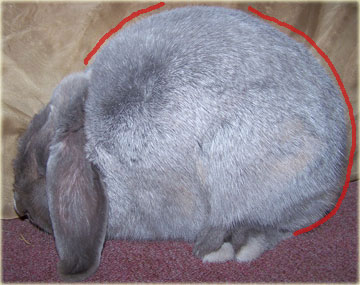 |
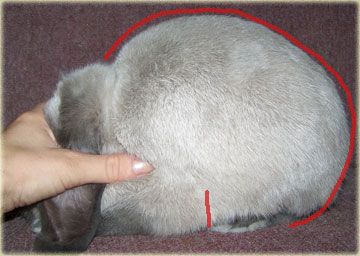 |
| This doe peaks too soon (see where the first red line is). When I say "peaks too soon", it means that her rise does not gradually go up, but immediately goes up. This doe is also undercut in her HQ's. A lot of times when the animal peaks early, they will be undercut in the HQ's. You will also want to flip the rabbit over to make sure it is not cow-hocked in the HQ's. | This buck is a very good example of sloped & undercut hindquarters. Noticed how sloped off his hind end is and how far under his feet are. |
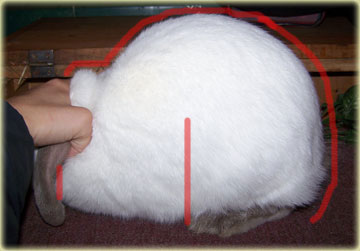 |
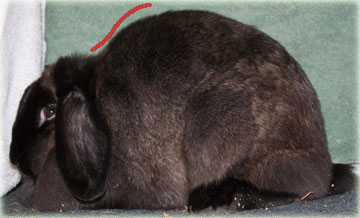 |
| This buck is also longer in his body than what he should have. He also has additional faults though. His shoulders are low, which therefore makes his rise start late. | This is another example of low shoulders. See the dip right behind her crown? |
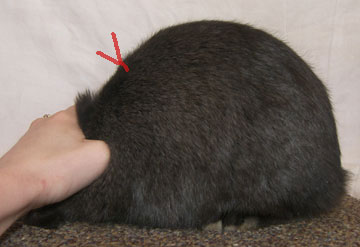 |
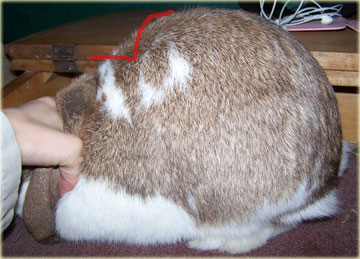 |
| This is a very good example of long shoulders. See where the red "V" is, that is where his rise starts. His rise should start at the back of his crown. | This also shows long shoulders, which is different than low shoulders. You can see in this picture where his rise starts, when it should be at the base of his neck. |
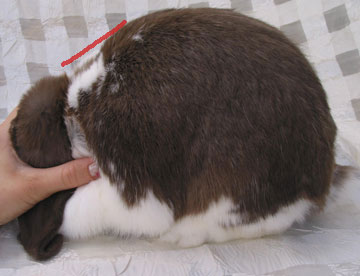 |
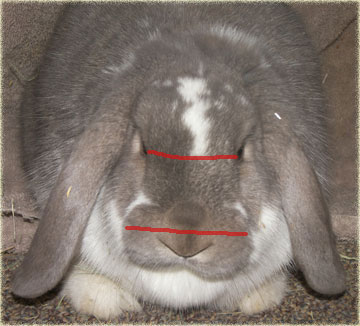 |
| Another example of long shoulders. | This doe is too narrow between her eyes and her muzzle isn't very wide either. Ideally, both places should be more like the rabbits pictured in the first set. |
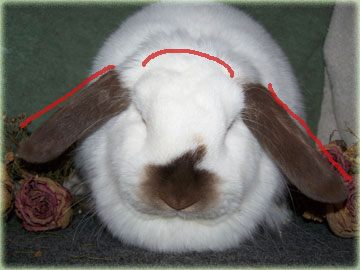 |
|
| This is an example of a crown that it too narrow (tight), which therefore makes the ears not freely fall down the side of the head. You can clearly see how wide & full the crown should be in the first set of pictures. |
This diagram below was put together by Laura Freeman of Locket Lops. I sent her a picture of a correctly posed and typed Mini Lop and she put together this great diagram. Feel free to print this out and use as an educational resource. If you click on the image, it'll open up a larger file for printing.
FINE PRINT: Please be sure to leave the watermark on the diagram as well as all text. No cropping. These files are appropriate for printing. These are for educational and non-profit only, please no making apparel, logos, etc. out of them. If you have any questions regarding use, feel free to email Laura.

